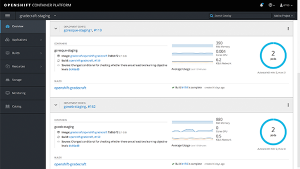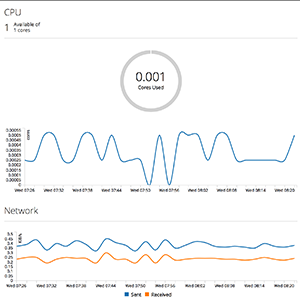
It takes many people to ensure software applications run correctly, and the Software Development team at the Center for Academic Innovation knows that all too well.
The latest improvement for GradeCraft — an online learning management system for faculty and students — is its migration to the Information and Technology Services (ITS) Container Service. Since its inception, Gradecraft was designed to run as a series of “containers.”
According to Ollie Saunders, software developer at Academic Innovation, “Think of a container as a box that contains everything you need to run an application—you can easily move these boxes about and host them on anything from your laptop to a huge supercomputer cluster. You can also bring in additional boxes to meet increased demand.”
“Essentially, migrating GradeCraft to OpenShift has allowed the team to continue providing the same service in a significantly less expensive, more secure, and more robust way.”
Ollie Saunders, Software Developer, Academic Innovation
Increased efficiency, reduced cost
GradeCraft had been hosted on Kubernetes, a Google software platform designed to run scalable containerized applications with many users; and the Academic Innovation team managed a Kubernetes cluster dedicated to Gradecraft within the Amazon Web Services (AWS) cloud platform.
RedHat’s OpenShift, based on Kubernetes, is the cluster software used by the ITS Container Service, which maintains OpenShift clusters in AWS. In switching to the Container Service for hosting, Academic Innovation maintained its presence in the cloud while using the managed service provided by ITS.

According to Saunders, the team migrated GradeCraft to the Container Service to increase efficiency and decrease cost. “The main reason we did this is that, historically, GradeCraft was running on Amazon Web Services, which is a very popular way of running applications,” Saunders said. “There are a couple of issues. The two major issues are it’s very expensive, depending on what level of hardware you need, and the other issue is that it’s effectively self-managed, so if anything goes wrong, we have to deal with it.”
The goal of GradeCraft’s migration had been its longevity and, with the Container Service, this goal could be actualized. The Container Service is significantly less expensive and the platform is more secure than the previous hosting environment.
“Now the great thing about OpenShift running at U-M is ITS has similar resources to a large enterprise or global organization, and so they can basically offer that level of around-the-clock support that we can’t,” Saunders said.
Key partnerships make for a smooth transition
With the support of ITS, the Software Development team seamlessly made the transition to the Container Service without impacting GradeCraft users.
Erik Barroso, software developer at Academic Innovation, said he focused on tackling GradeCraft’s customized code. As he prepared GradeCraft for migration, he was surprised by the amount of custom code previously written to support the application for AWS.
“Over time, these things got built together in a sort of Frankenstein manner with more complex code than we anticipated,” he said. “So it was a lot of work to identify how much we were depending on the custom code we wrote to put things on the Amazon system.”
Academic Innovation’s Software Development team learned more about the Kubernetes infrastructure when migrating GradeCraft to OpenShift. Sundeep Nagumalli, systems administrator at Academic Innovation, said the migration was more complicated than just moving files around.

It took him several months to understand how to operate OpenShift on his own machine before applying his knowledge to the publicly available systems that now host GradeCraft. “We worked on Kubernetes infrastructure for a good amount of time to understand how OpenShift really works in real-time,” he said.
Chris Kretler, ITS service manager for Container Service, worked closely with Nagumalli and Saunders to familiarize them with OpenShift, help them understand how to set up the necessary technologies required for the migration, and run initial prototypes of GradeCraft on the platform.
“This is an example of ITS collaborating with key university groups to create a service that is integral to the mission of the university.”
Chris Kretler, Service Manager for Container Service, ITS
He said that because GradeCraft was already a containerized application meant to run on Kubernetes, there were few technical issues, and the transition to OpenShift was pretty easy. “Given that the Container Service provides a managed Kubernetes service, Academic Innovation made a well-reasoned decision to leverage the service, ” Kretler said.
Kretler said one advantage of OpenShift is that the functionality to build and deploy applications are contained in a single platform. Instead of one paid service to produce (or “build”) the container image and a different one to run it, both aspects are now handled by OpenShift. This allows the Software Development team at Academic Innovation to make quicker changes in GradeCraft. Additionally, ITS maintains the OpenShift software and underlying AWS infrastructure.
ITS is aware GradeCraft is a high-profile application and is proud to provide technical support. “ITS is able to address the needs of the university community where there are significant demands,” said Kretler. “Academic Innovation and Engineering have been key partners. This is an example of ITS collaborating with key university groups to create a service that is integral to the mission of the university.”
Saunders said this migration, and support from ITS, improves the efficiency of GradeCraft in a way that is transparent to users. “Essentially, migrating GradeCraft to OpenShift has allowed the team to continue providing the same service in a significantly less expensive, more secure, and more robust way,” he said.
Dana Fair and Chris Kretler, both with ITS, contributed to this story.
